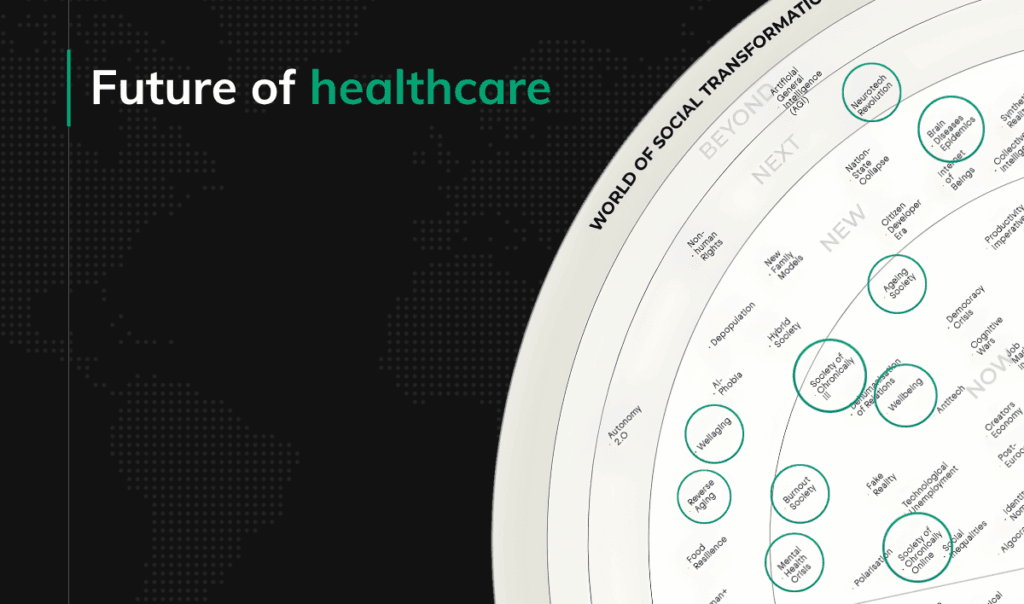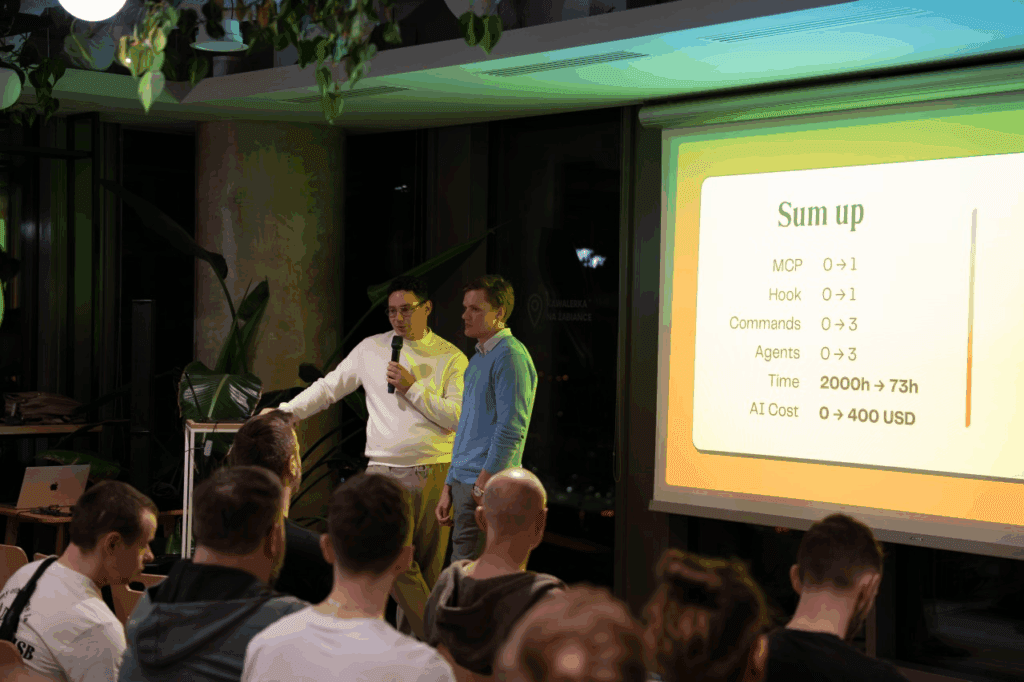AI’s Impact on Software Development: A CEO’s Perspective
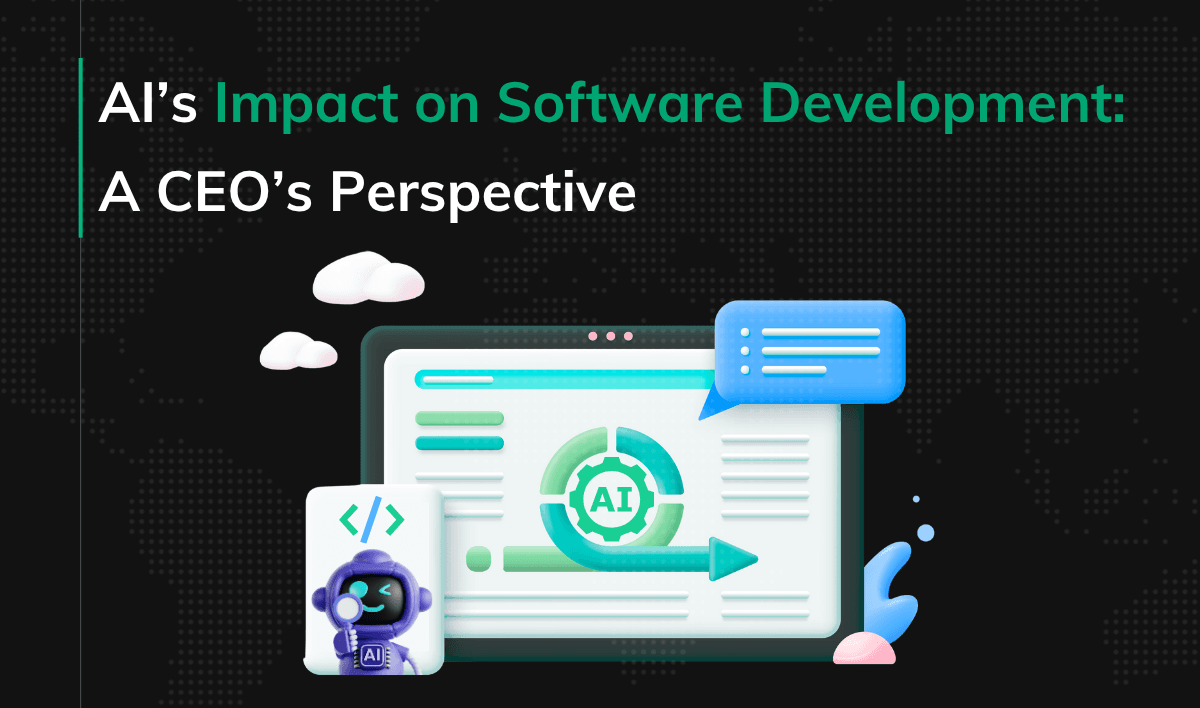
AI is shaking up software development fast. What we do today is miles ahead of just two years ago. But here’s the thing: many software companies are just dipping their toes into AI — they’re not diving in. Teams stick to old ways, picking up AI bit by bit. Only 25% of companies have fully integrated AI into their processes. This slow adoption is quickly polarizing the industry. AI tools are racing ahead, and keeping up today will define tomorrow’s advantage.
This isn’t just about coding faster or cutting costs. AI opens up new possibilities across the board. But it also creates real issues. Sometimes tasks are done in minutes instead of hours. Other times, they remain as complex as they were before. This makes it tough to plan projects.
Dev Teams using AI face new challenges. Think of mounting technical debt and shifting bottlenecks. Or changing roles for junior and senior devs. Even old ways of planning and managing products are under question.
In this article, we’ll unpack these shifts and show how developers, managers, and businesses can adapt—and thrive—in the AI era.
Note: This article was sparked by a heated discussion we had at our headquarters.
Key Points
|
Challenges and Solutions in AI-Augmented Development
Estimation Difficulty and Pricing Uncertainty
AI brings major speed gains—but also major unpredictability. Some tasks might be done in seconds, while others take longer than expected if the AI hits a wall. This variability makes it tough to estimate timelines or price projects accurately, especially under fixed-cost contracts.
We don’t yet have solid data on AI-augmented software development, which makes it hard to give accurate time estimates—especially with how fast AI is evolving.
—Wiktor Żołnowski, CEO of Pragmatic Coders
Since there’s limited organizational-level historical data from AI-heavy projects, it’s hard to forecast reliably. Even though some teams report 25–50% faster delivery times, those numbers change quickly as tools and workflows evolve. To better manage this uncertainty, teams should:
- Collect empirical data – Start tracking how AI is actually impacting delivery to inform future estimates. Introduce indicators such as hours per user story to monitor delivery trends over time.
- Use shorter, iterative cycles – Weekly cycles offer more control and make it easier to adapt.
- Split projects into smaller fixed-price stages – This reduces risk while still allowing for structured progress and clear deliverables.
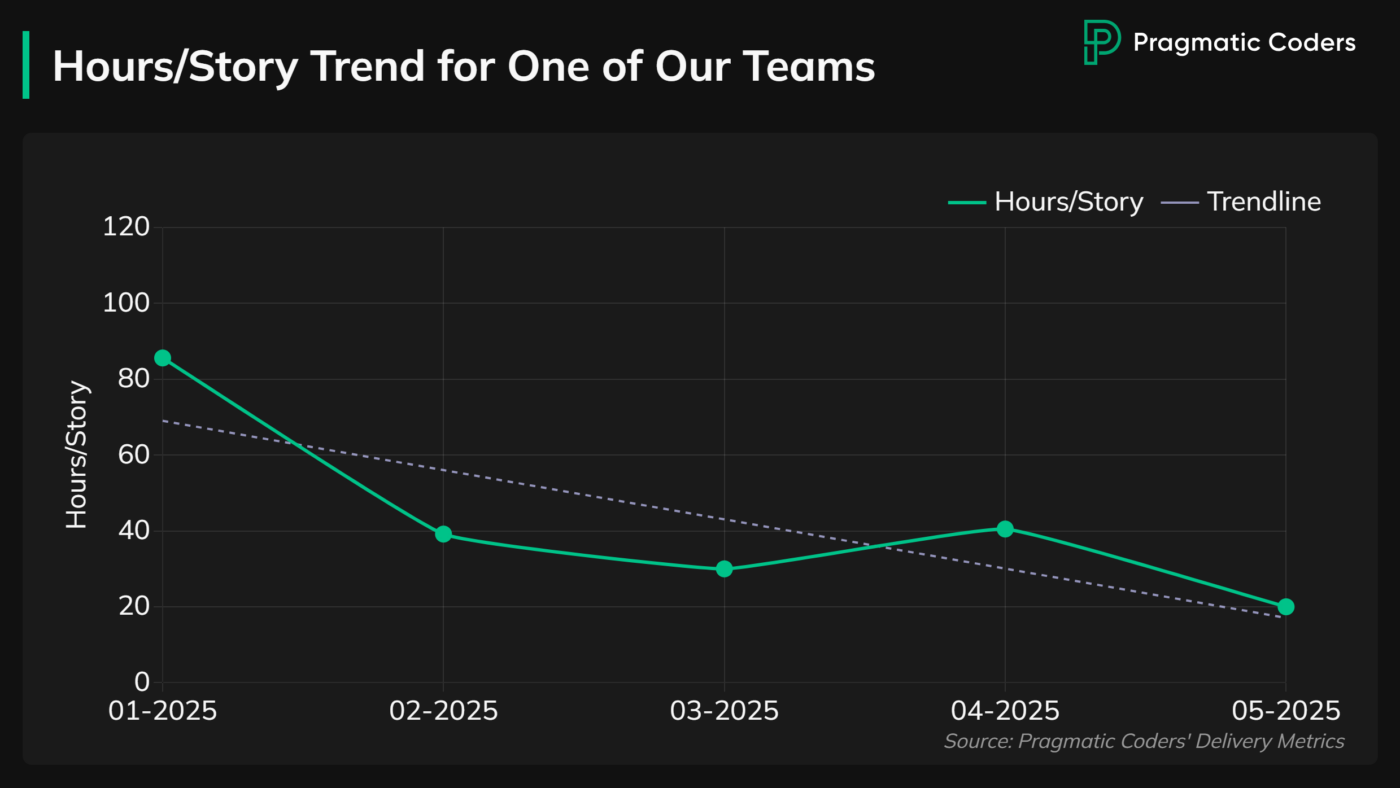
AI-Generated Technical Debt & Quality Guardrails
AI greatly speeds up code production. But that speed comes with a cost: the risk of growing technical debt and slipping code quality. AI-generated code often introduces unnecessary complexity, especially if left unchecked. The pressure to move fast can also lead teams to cut corners—like skipping tests or reviews.
The coding standards we’ve built over decades—like clean code and code reviews—matter more than ever. To master AI-augmented development, you first have to master the fundamentals. Otherwise, you’ll just create chaos.
—Wiktor Żołnowski, CEO of Pragmatic Coders
To manage these risks and keep quality high, teams should follow a few key practices:
- Thorough code reviews – Senior developers must rigorously review AI-generated code to catch hidden issues and prevent technical debt.
- Stronger quality practices – Reinforce fundamentals like automated testing, unit tests, and Test-Driven Development (TDD).
- Clean Code discipline – Apply Clean Code principles—meaningful naming, small and focused functions, clear intent, and eliminating duplication—to keep AI-generated code readable and maintainable.
- AI-assisted testing – Make it standard for AI to generate both code and its tests simultaneously.
- Evolving coding conventions – Use detailed, regularly updated “convention files” to guide AI output. These should embed clean code principles like SOLID and DRY and evolve based on team experience and past mistakes.
Managing AI-Driven Complexity & Bottlenecks
As AI models, external SaaS tools, and advanced automation are layered into systems, overall complexity increases. That makes it harder to spot bottlenecks or predict where things might break. AI-generated code can be more opaque than human-written code, adding another layer of difficulty when diagnosing issues or debugging.
It used to be easier to spot bottlenecks—you could almost see where a system might break under scale. But with today’s AI calls, third-party integrations, and growing complexity, predicting failure points has become a real challenge. Scaling isn’t just harder—it’s less predictable.
—Paweł Miżwa, Senior Developer at Pragmatic Coders
To manage this complexity, teams should adopt practices that increase clarity and flexibility:
- Maintain high code quality (again) – Stick to clean, consistent standards to reduce confusion later.
- Use AI to assist documentation – Well-documented systems are easier to troubleshoot and evolve.
- Favor modular architectures – Structures like hexagonal architecture or plug-and-play patterns make it easier to isolate, replace, or upgrade components without major disruption.
Controlling AI Service Costs at Scale
AI services usually charge per request, which works well for MVPs or small apps. But as usage grows, costs can spike fast—turning a cheap prototype into an expensive platform. That makes cost monitoring and proactive budgeting essential from day one.
To keep spending under control, teams should consider:
- Switching to self-hosted models at scale – This can provide more predictable infrastructure costs.
- Running cost-benefit analyses regularly – Evaluate usage patterns to decide when external services stop making financial sense.
- Tracking usage closely – Keep an eye on request volume to avoid surprises and plan ahead for scaling decisions.
Keeping Pace with Rapid AI Tool Evolution
AI tools evolve fast—and development teams need to keep up. That means regularly setting aside time for research, testing, and hands-on experimentation with new tools and techniques. Staying current isn’t optional—it’s a core part of staying competitive.
To support this kind of continuous adaptation, organizations should:
- Provide safe, version-controlled environments – These allow teams to test and roll back tools without risk.
- Design flexible architectures – Systems should make it easy to swap or update components as new AI capabilities emerge.
- Encourage structured experimentation – Treat tool exploration as a routine, not a side project.
Adapting Agile Processes & Team Dynamics for AI
Traditional agile setups—like two-week sprints—are struggling to keep up with the speed of AI. Planning ahead is harder than ever, as new tools and capabilities result in velocity fluctuations. Product Owners often find themselves overwhelmed, trying to provide direction in a constantly shifting landscape. Meanwhile, communication gaps grow wider as teams and stakeholders fall out of sync, slipping into isolated workflows instead of collaborating tightly.
Two-week iterations are just too long now. In that time, new models drop, tools evolve, and entire assumptions shift. If your team can build a lot in two weeks—and it should—that much change makes upfront planning almost meaningless. We need faster, tighter loops. The way we build software has to evolve.
—Wiktor Żołnowski, CEO of Pragmatic Coders
To stay effective in this fast-moving environment, teams should consider:
- Shorter iteration cycles – Move to 2–3 day sprints for faster feedback and more frequent course correction.
- Dynamic planning – Replace static backlogs with flexible, real-time planning practices.
- Adaptive product ownership – POs must embrace shorter decision cycles, use AI tools to stay aligned, and prioritize agility over rigid roadmaps.
Let’s now dive deeper into each product team role in the context of rapidly evolving AI tools.
How AI Redefines Software Team Roles
The introduction of AI tools significantly alters dynamics, responsibilities, and required skills within software development teams. The evolving environment demands new capabilities and closer collaboration across all roles.
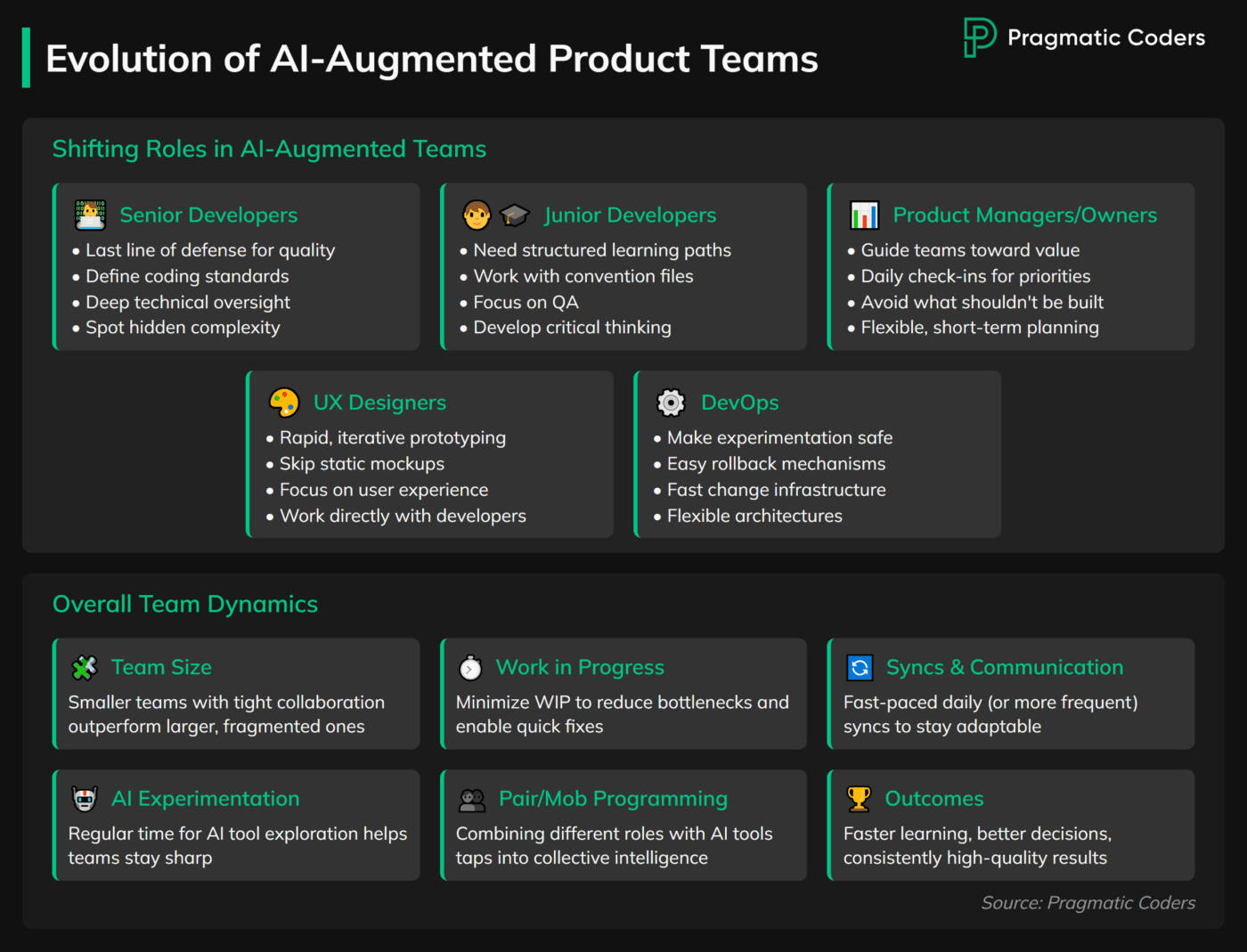
Senior Developers: Quality Gatekeepers in AI Workflows
As AI takes on more of the coding workload, senior developers become the last line of defense for quality. Their deep understanding of both theory and practice is essential for reviewing AI-generated code, spotting hidden complexity, and catching technical debt early—before it becomes a problem.
Beyond code reviews, senior developers also shape how AI writes code. They define and maintain detailed coding standards and “convention files” that guide AI behavior. Even small teams need at least one senior developer focused on this oversight role to ensure the output stays clean, scalable, and aligned with best practices.
Junior Developers: Growing Talent in an AI World
AI’s speed and efficiency can make junior developers look less cost‑effective in the short term, but it won’t replace them. Sidelining juniors today starves the pipeline of tomorrow’s senior talent, so teams must design clear, structured growth paths—especially in fundamentals like quality assurance and managing code complexity.
Convention files help juniors work alongside AI more effectively, but that’s not enough. Teams must find creative ways to accelerate junior growth—pairing them with mentors, involving them in code reviews, and teaching them how to think critically about code, not just write it.
Product Owners: Navigating Fast-Moving AI Roadmaps
With the rapidly increasing pace of software development, Product Owners must adapt fast. Their role becomes even more critical—not just in defining what should be built, but in avoiding what shouldn’t be. Since AI can generate outputs quickly, POs must guide teams toward work that truly adds value and aligns with strategy.
AI has accelerated development so much that Product Owners are sometimes struggling to keep up. Many are lost in the fog—unsure what to deliver or how to support their teams.
—Paweł Miżwa, Senior Developer at Pragmatic Coders
To keep up, POs should use AI tools themselves for faster decision-making and real-time course correction. The shift is away from static roadmaps and toward flexible, short-term planning cycles. Daily or near-daily check-ins with the team help ensure that priorities stay clear and feedback loops stay tight. Some POs may even shift further into strategic leadership, focusing more on long-term vision while letting others handle the day-to-day details.
UX Designers: Rapid Prototyping with AI
UX designers need to shift gears—fast. Instead of sticking to rigid design systems, they should focus on rapid, iterative prototyping that centers on user experience, emotional impact, and flow. It’s about getting real feedback sooner and using it to refine designs continuously. On top of that, there’s a growing need to design with AI agents in mind.
Code used to be the bottleneck—expensive and slow to build. That’s changed. Today, it often makes more sense for UX Designers and developers to skip static mockups and go straight to working prototypes. With AI in the loop, they can test, iterate, and adapt in real time—right next to their users.
—Paweł Miżwa, Senior Developer at Pragmatic Coders
This means working closely with developers—sometimes even side by side through pair or mob programming. By testing early prototypes (possibly generated with AI), designers can give faster input and stay tightly aligned with the build process. The goal: shorter loops, smarter designs, and better user outcomes.
DevOps: Building Safe, Flexible AI Infrastructure
As AI accelerates development cycles, DevOps becomes even more essential—though often behind the scenes. Their job is to make rapid experimentation safe and sustainable. That means building infrastructure that supports fast changes without breaking things.
Version-controlled environments, easy rollback mechanisms, and flexible architectures like hexagonal design or plug-and-play components are no longer nice-to-haves—they’re critical. DevOps teams must ensure that developers can move fast, test often, and recover instantly when needed.
Team Dynamics in High-Velocity AI Delivery
In AI-augmented environments, smaller teams with tight collaboration outperform larger, fragmented ones. To keep things flowing smoothly, teams should keep Work in Progress (WIP) low. That boosts availability, reduces bottlenecks, and allows for quick problem-solving when issues arise.
Fast-paced syncs—daily or even more frequent—and regular time set aside for AI experimentation help teams stay sharp and adaptable. Practices like pair or mob programming, especially when combining different roles and AI tools, tap into the team’s collective intelligence. The result: faster learning, better decisions, and consistently high-quality outcomes.
Strategic AI Business Considerations for CEOs
The integration of AI into software development is not merely a technological change; it profoundly reshapes the strategic and economic landscape. Businesses must navigate evolving challenges and leverage opportunities created by AI-driven development.
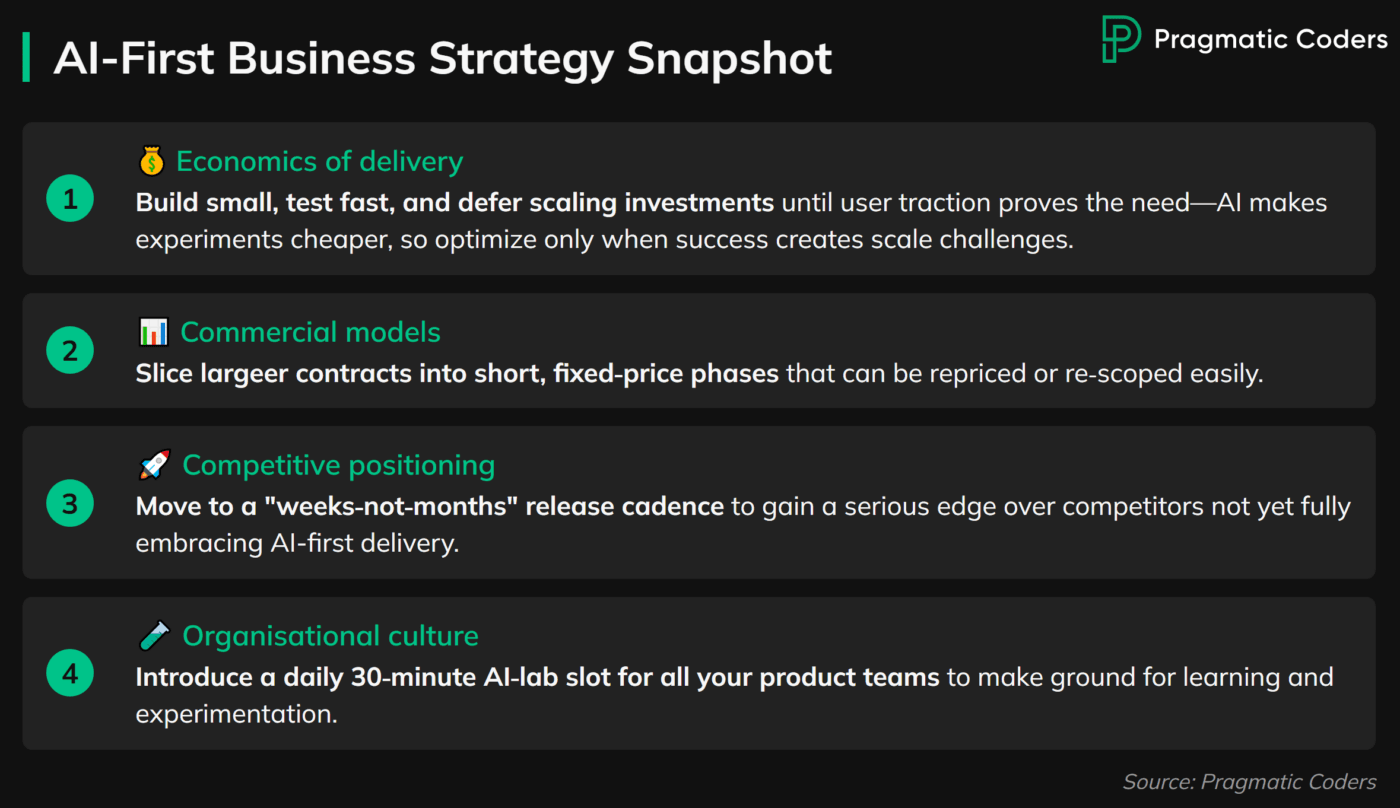
Rethinking Contract Models in the AI Era
AI is making software development much faster—often 1.5 to 2 times quicker than before. That creates pressure to rethink how contracts are structured.
For software houses, fixed-price contracts are becoming more attractive. If they can deliver faster thanks to AI, they can offer lower prices to win deals and still keep strong margins.
But there’s a catch for clients. Because AI tech is evolving so quickly, today’s prices might look high in just a few months. That makes long-term fixed-price deals risky on their side.
A smart solution? Break big projects into smaller fixed-price phases. That way, both sides can adapt as the tech (and its costs) change. It’s a flexible approach that helps balance risk and reward.
Leveraging Lower Up-Front Costs with AI
AI is changing the game for innovation—mainly by making it much cheaper to build custom solutions. Creating AI-powered agents that handle specific tasks now costs far less than building traditional software to do the same thing.
This shift lowers the barrier to entry. Companies can design and test new ideas quickly and affordably, even in areas that once seemed too risky or niche. The cost of failure is low, which encourages more bold experiments.
If your AI system starts buckling under the weight of 10,000 users, that’s a good problem to have—because those users are proof you’re succeeding. Optimize when it hurts, not before. Until then, focus on delivering value.
—Wiktor Żołnowski, CEO of Pragmatic Coders
And here’s the smart part: scaling costs—like those tied to usage-based AI services—only become a concern if the idea actually takes off. That means businesses can take a “build small, test fast” approach, then invest more once they see real traction.
Securing Market Position & Competitive Advantage with AI
Companies that fully embrace AI across their operations are stepping into a wide-open market—with little competition and big advantages.
These early adopters move faster, work more efficiently, and deliver more. That kind of performance quickly resets customer expectations and puts them in a strong position to lead their space.
We don’t have all the answers yet—and that’s okay. We’re in the middle of figuring it out through experimentation. But where most see uncertainty, I see opportunity. Very few software companies are truly going AI-first. If you’re even 1.5x faster than the rest, you already have a serious edge. Twice as fast? That’s a game changer.
—Wiktor Żołnowski, CEO of Pragmatic Coders
For these firms, speed is the new standard. Instead of planning in months, they talk in weeks. That shift isn’t just about tools—it’s a whole new way of working that rewards fast, flexible, AI-driven delivery.
Creating Space for Everyday AI Exploration
To stay ahead, teams need to carve out regular time for experimenting with new AI tools. That small daily habit can lead to big breakthroughs.
But it only works with the right setup. Teams need safe, flexible environments where they can test ideas, move fast, and undo changes when needed.
We’re stuck in a culture of overutilization—where 150% productivity sounds ideal. But the truth is, slack time isn’t wasteful; it’s essential. It gives people room to explore, learn, and adopt better tools—especially AI. That space is where innovation actually happens.
—Wiktor Żołnowski, CEO of Pragmatic Coders
This also means rethinking how we measure productivity. Instead of pushing everyone to be 100% busy, it’s smarter to keep team members more available. Less multitasking, fewer active user stories, and more focus. The goal is to improve flow, eliminate bottlenecks, and keep innovation going — every single day.
Conclusion
AI-driven changes in software development affect more than just technology. They reshape business strategy, costs, talent management, and market reality. Companies need to adapt quickly to handle uncertainty. Embracing AI fully and strategically will allow businesses to thrive, creating lasting competitive advantages in this fast-changing industry.






